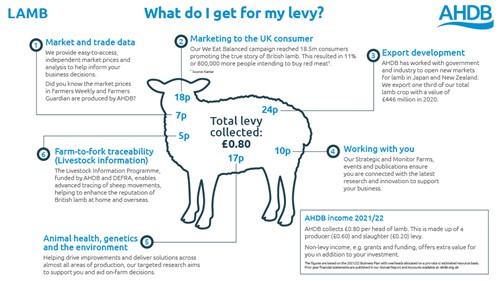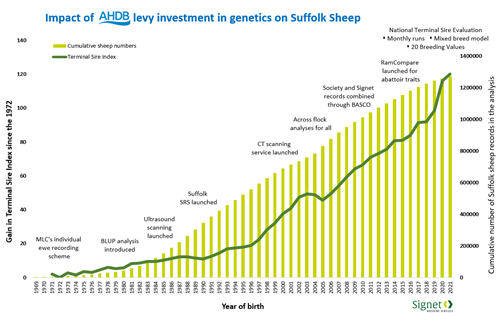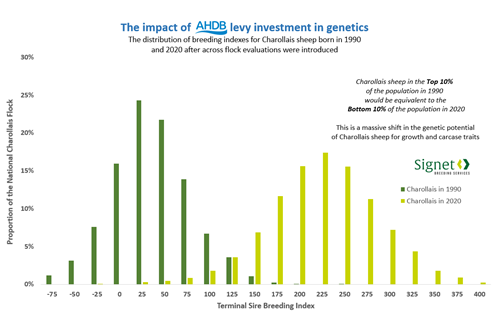Sam Boon Ahdb Beef and Lamb
The role of AHDB Levy Funds in the Genetic Improvement of the National Flock

Samuel Boon talks about the potential impact of the upcoming levy payer vote on AHDB activity realtign to performance recording and genetic improvement
 Decision time for levy payers
Decision time for levy payers
In Spring 2022 beef and lamb levy payers will be asked how they want to see the levy that they pay to AHDB invested. AHDB currently collects 80p per head from every lamb slaughtered in English abattoirs; 60p from the producer and 20p from the abattoir.
This levy is invested in a range of services including marketing, export development, the collation of market data and traceability work; with 17p split between those services aimed at enhancing animal health, reducing environmental impact and increasing genetic gain.
What do sheep farmers want and what do they need?
In my experience, when asked how they would like to see their levy spent, many commercial sheep producers would answer "more on marketing", understandably attracted to areas of spend expected to enhance the immediate value of their livestock.
However, an investment of levy dominated by marketing tends to overlook the longer-term gains obtained through genetic improvement. The cumulative and lasting impact of genetic selection means investment in this area is also highly cost effective; with genetic improvement programmes already responsible for major productivity gains in every major sheep producing country across the world, which I am pleased to say includes the UK.
We have come a long way
One of the initial remits behind the collection of a beef and lamb levy in 1967 was to promote the performance recording of livestock, to provide ram and bull buyers with accurate information to assess an animal's genetic merit – rather than relying on visual assessment. Since then, many milestones have been reached, each having an impact on rates of genetic gain.
Look at this example for Suffolk sheep, whose genetic improvement journey has been supported by levy for the best part of 50 years, contributing towards the National Terminal Sire Evaluation which now contains over a million Suffolk records.

The terminal sires we breed today are very different to those of the 1980s and 90s. Lambs by modern terminal sires grow faster, have better conformation and are less likely to become overfat at light carcase weights. This improvement isn't limited to the progeny of rams purchased from Signet recorded flocks; through the movement of genetics within the pedigree world the whole breed benefits when influential flocks record their stock.
This genetic change has clearly influenced the productivity of the national flock, but it should not be forgotten that by reducing days to slaughter, enhancing meat yield in the carcase and increasing maternal output, genetic improvement programmes also provide one of the best ways to reduce the carbon footprint of lamb; as they have quietly done for the last four decades without us realising it.
The chart below showing the genetic change in the Charollais breed indicates just how far breeds have come through the use of performance recording. The elite Charollais sheep in 1990 that would have been the sires from whom semen was taken for wider use would now be amongst the very worst in the breed today in terms of their genes for growth and carcase attributes. That is quite simply an incredible change.

Levy funded genetic research and service development has seen many breakthroughs over the years, which include:
- Statistical analysis of sheep records (1980s)
- Launch of the ultrasound scanning service (late 1980s)
- Across flock evaluations and support for Sire Reference Schemes (1990 onwards)
- Launch of the CT scanning service and the development of breeding values for CT traits, including the ability to assess lean meat yield, spinal length, gigot shape and intramuscular fat (1998 onwards)
- Development of breeding values from abattoir data (via RamCompare ) (2015/16)
- Mixed breed evaluations, with the inclusion of crossbred data (2018)
- Full online reporting and free inbreeding software (2019)
In our maternal programmes we have developed the following:
- Breeding values for ewe longevity and lamb survival (2014)
- Novel traits for assessing worm resistance, like FEC (2000) and Serum IgA (2021)
- Breeding values for ewe mature weight and body condition score (2022)
A look to the future of AHDB funded research and the cost of recording with Signet
The next steps for Signet Breeding Services and AHDB's levy investment in genetics are less clear, as much will depend on the resources available after producers have had their say in the spring vote.
- Clearly a major goal would be the move to incorporate genomic information into our evaluations, a potential game changer in the provision of breeding evaluations which could provide more accurate breeding values to both recorded and unrecorded flocks.
- New phenotypes that have the potential to reduce environmental impact require consideration, as we see the impact that portable atmosphere chambers are having in New Zealand for example. Existing phenotypes could also be used more effectively to counter the environmental concerns aimed at sheep and beef production.
- RamCompare, though widely deemed a great success is in many ways simply a pilot to show the potential for progeny testing and the analysis of abattoir data. Further resources could provide a significant catalyst to increase the industry level impact of this work as well as strengthening the genetic comparisons we make between different rams, flocks and breeds.
In the short term, we shouldn't forget the impact levy has had for many years supporting the recording costs incurred by ram breeders. Levy typically covers half the cost of CT scanning and about 30-40% of the true cost of ultrasound scanning, with similar support provided to subsidise basic flock recording costs and the development of Signet's industry facing website www.signetdata.com.
Keeping Signet's recording costs low is really important if we wish to enhance the impact of our work on the national flock; genetic improvement currently worth over £20 million per annum to the UK sheep and beef industry (AbacusBio 2015), making it a fantastic return on your levy investment.
What can I do?
In April 2022, we'll be asking all eligible levy payers to have their say and shape our work and areas of priority. Your views will help guide what we deliver over the next five years. In order to make sure you are able to vote, you must first register and provide enough information for us to verify you as a levy payer.
Businesses that are eligable to vote include any business that kept pigs, sheep or cattle in England, any business (such as meat processors) that slaughtered pigs, sheep or cattle in England, or any business that purchased pigs, sheep or cattle in England for export. Registration is now open so please register now.
Source: https://www.signetdata.com/news/posts/2021/december/the-impact-of-the-ahdb-vote/

0 Response to "Sam Boon Ahdb Beef and Lamb"
Post a Comment